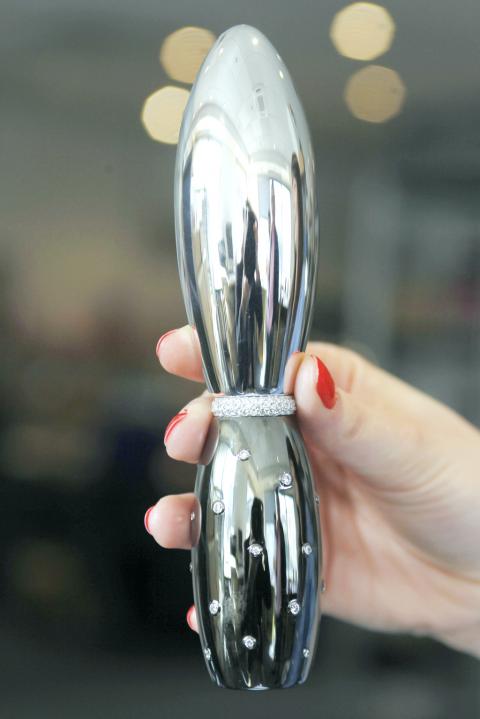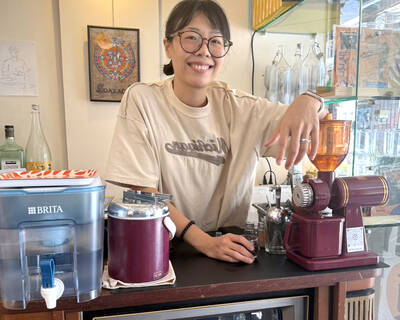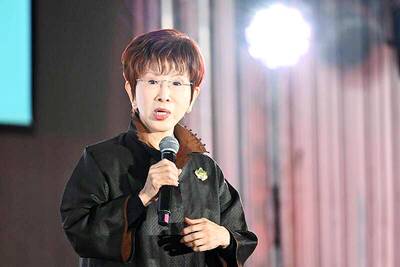Toothpaste? Check. Tampons? Check. Vibrator? Check!
For years, vibrators were bought quietly in sex shops, and later online, arriving in discreet unmarked packages. They were rarely discussed, other than perhaps during a late-night girl-talk session fueled by many glasses of pinot grigio. But now you can find them advertised on MTV and boldly displayed at mainstream drugstores.
The newest model on the shelves is the Tri-Phoria, created by the condom company Trojan after a study the company conducted in 2008 in partnership with the Center for Sexual Health Promotion at Indiana University revealed that over half of American women had used vibrators, and of that group, nearly 80 percent had shared them with their partners. James Daniels, vice president for marketing at Trojan, said: “The idea really came from consumers. They kept telling us vibrators, vibrators. And we just laughed. And then we realized they were serious.”

Photo : AFP
The Tri-Phoria joins the A:muse Personal Pleasure Massager by LifeStyles, which arrived in stores in January, and the Allure, by Durex, which made its over-the-counter debut in 2008. Alan Cheung, senior brand manager for Durex, said that sales of the company’s vibrating products are up 60 percent over the last six months, compared with the same period last year. “Consumers are definitely not shy about this kind of purchase in the retail environment,” he said.
This comes as no surprise to Rachel Venning, a founder of Babeland, a chain of sex-toy stores that opened a store in family-friendly Park Slope, Brooklyn, in 2008 to nary a ripple of protest. “I know women will buy them at Duane Reade, and as a lifelong cheerleader for sexual empowerment I’m thrilled at this development,” Venning said. “It’s one more step in the evolution of vibrators to just another consumer product, unburdened of its freight of shame, sexual defect and sluttiness.”
Liz Canner, who directed the 2009 documentary Orgasm Inc, agrees. Her film confronted pharmaceutical companies that suggested women were dysfunctional, and therefore needed some sort of medicinal or therapeutic help, if they could not climax during sex. “It’s easier in a repressed culture to have a disorder than go to a sex store and get a vibrator,” Canner said in a recent interview. “Vibrators have been shown to enhance sexual pleasure for over 100 years now. Why not partake?”
Vibrators made occasional cultural cameos in the 1990s, with scenes in films like She’s the One and Slums of Beverly Hills. But it wasn’t until an episode of HBO’s Sex and the City — called The Turtle and the Hare, featuring an actual device called the Rabbit Pearl — that the vibrator truly emerged from the nightstand drawer.
“Sex and the City did as much for women’s sexual comfort as really anything has done in the past couple of decades,” said Laura Berman of In the Bedroom With Dr Laura Berman, on OWN: Oprah Winfrey Network.
Berman, a prominent sex and relationship expert, also has a line of sex toys (drlauraberman.com), which she said grossed US$5 million last year, up from US$100,000 in 2005. After one appearance on Oprah that focused on adult women who had problems climaxing, one of her top-selling products, the Aphrodite, “was back-ordered forever,” she said. And in 2006 she sparked a national debate when she encouraged mothers to buy vibrators for their teenage daughters. “If she gets hot and bothered on a date,” Berman said about the daughter, “she can go home and self-stimulate, instead of getting pregnant.”
(Of course, a plastic battery-powered device is not needed for self-stimulation, but there is no market potential in that idea.)
Assessing the vibrator’s current ubiquity, Berman said, “Women are getting less and less caught up on an unrealistic and puritanical vision of what a good girl is. When they can embrace their self-stimulation, they can take ownership of their sexuality.”
Men interviewed proclaimed themselves not only unthreatened by the addition of accessories to their partners’ sex lives, but downright enthusiastic. Jeremy, 31, a content strategist in the entertainment business who lives in New York and wanted his last name omitted for privacy, said: “From my perspective, a woman who has thoroughly explored her own body, both alone and with or without whichever toys she finds interesting, makes for a significantly better lover.”
Kate, 29, a programming coordinator in New York who has been Jeremy’s girlfriend for a year and a half, calls herself “an evangelist for vibrators.” In college, she recalled seeing a Hello Kitty-themed one. “I wanted it just because it was kitschy and cool,” she said. “I thought it was so ridiculous that I ended up doing a bit more research and started to take it seriously.”
Kate, a devoted Babeland customer, said that at one point she asked her friends to pool their money and buy her a fancy vibrator for her birthday, which she promised to review for them.
And when Lou, 44, who lives on Long Island and has been married to Sarah, 47, for 20 years, was found to have prostate cancer, he used a make-your-own vibrator kit to make a mold of himself for his wife before having surgery.
“It never entered my mind that, oh, my God, this was bad,” he said.
Carol Queen, who is the curator of the Antique Vibrator Museum and a staff sexologist for Good Vibrations, a sex-toy retailer since 1977 that bills itself as the “original clean well-lit place to buy vibrators,” attributes more-honest discussions about sex and pleasure to fear of HIV/AIDS in the early 1990s, which led to frank discussions about condoms. She also mentioned a shift in published erotica at that time.
“There was something of a pendulum swing from the sex conservatism of the 1980s to the lively sex publishing of the 1990s, zines, anthologies, small presses,” she said. “Then people in more-mainstream venues heard about toys. As soon as mainstream culture looks at an issue, it becomes fair game for everyone else.”
And now, thanks to Suki Dunham, 43, vibrators also have an iPhone app.
Dunham, a former business manager for Apple, was a stay-at-home mother for four years before founding OhMiBod, a line of vibrators that synchronize rhythmically with iPods, iPads, iPhones and other smartphones. (But, she said, “Our product line won’t be sold at the Apple store anytime soon.”) She got the idea after her husband, Brian, who was then traveling frequently for his job at Tyco, gave her an iPod and a vibrator for Christmas.
He later quit to help his wife market her invention, which has faced some hurdles. Nylon Magazine refused to run an ad, Dunham said. And the federal Small Business Administration denied her loan application because they said she ran a “prurient” business.
“I can sit with my 10-year-old daughter during prime-time TV and watch a commercial for Viagra,” Brian Dunham said, “but I can’t advertise our OhMiBod fan page within Facebook.”
OhMiBod’s Freestyle :G is more expensive than the drugstore versions, at US$120, a price comparable to other models from Jimmyjane, Lelo and Je Joue. Perhaps the top of the line is the Lelo Inez, which for US$13,500 offers a “virtually silent” engine, according to the company, and either a 18-karat gold-plated or stainless steel finish. But inconspicuous consumption remains the industry standard. Berman said she packages her toys in what look like “perfume boxes.” Trojan offers a discreet lavender box. Passion Parties is a direct sales company that offers products at in-home parties, during which women place orders with a salesclerk in a private room. “We don’t have a porn star on the package. To us that’s just degrading,” said Pat Davis, the company president. “There is still a strong desire for the confidentiality of it.”
The ability to shop online has surely helped the rising popularity of vibrators; Good Vibrations’ business has grown by 60 percent since the 1990s. “I am all about the Internet,” said Ellie, 32, a student and Babeland customer in Old Town, Maine. “People want them, but they don’t want to go to the creepy stores with the creepy people.”
But the creep factor has also decreased significantly since vibrators began to be portrayed in popular culture. Berman’s vibrating panties appeared in the 2009 movie The Ugly Truth, starring Katherine Heigl and Gerard Butler. “That scene would not have been in a major Hollywood movie 10 years ago,” Berman said. Her products were also in a recent episode of Private Practice on ABC, though they remained in the boxes.
And Kandi Burruss, a singer-songwriter and one of Bravo’s Real Housewives of Atlanta, has decided to create a line of vibrators with Dunham’s help.
The history of the device is an ongoing source of fascination. In a poke at early 1960s prudishness, an episode in the first season of Mad Men featured a wired girdle called the Electrosizer. Sarah Ruhl’s critically acclaimed 2009 Broadway play, In the Next Room (or The Vibrator Play), explored the socio-cultural reasons behind the invention of the vibrator, which was to treat “hysterical” women medically, in the 1880s.
And Hysteria, a romantic comedy in post-production that will star Maggie Gyllenhaal and Hugh Dancy, will recount the same point in Victorian history. The plot revolves around Dancy’s character, a young earnest doctor who takes a job massaging women’s pelvises into “paroxysms.” But when the doctor develops carpal tunnel syndrome, his best friend (Rupert Everett), who is obsessed with electricity, invents a device that has impressively efficient curative powers.
“Americans are ready to laugh at the vibrator as a medical device,” said Tanya Wexler, the director of Hysteria, whose movie takes a winking look at what Canner alludes to in her documentary: the medical treatment of women who aren’t perfectly orgasmic — about which Wexler feels similarly perplexed.
“People don’t need doctors for it,” she said. “They just need a little bit of freedom.”

Cheng Ching-hsiang (鄭青祥) turned a small triangle of concrete jammed between two old shops into a cool little bar called 9dimension. In front of the shop, a steampunk-like structure was welded by himself to serve as a booth where he prepares cocktails. “Yancheng used to be just old people,” he says, “but now young people are coming and creating the New Yancheng.” Around the corner, Yu Hsiu-jao (饒毓琇), opened Tiny Cafe. True to its name, it is the size of a cupboard and serves cold-brewed coffee. “Small shops are so special and have personality,” she says, “people come to Yancheng to find such treasures.” She

The low voter turnout for the referendum on Aug. 23 shows that many Taiwanese are apathetic about nuclear energy, but there are long-term energy stakes involved that the public needs to grasp Taiwan faces an energy trilemma: soaring AI-driven demand, pressure to cut carbon and reliance on fragile fuel imports. But the nuclear referendum on Aug. 23 showed how little this registered with voters, many of whom neither see the long game nor grasp the stakes. Volunteer referendum worker Vivian Chen (陳薇安) put it bluntly: “I’ve seen many people asking what they’re voting for when they arrive to vote. They cast their vote without even doing any research.” Imagine Taiwanese voters invited to a poker table. The bet looked simple — yes or no — yet most never showed. More than two-thirds of those

In July of 1995, a group of local DJs began posting an event flyer around Taipei. It was cheaply photocopied and nearly all in English, with a hand-drawn map on the back and, on the front, a big red hand print alongside one prominent line of text, “Finally… THE PARTY.” The map led to a remote floodplain in Taipei County (now New Taipei City) just across the Tamsui River from Taipei. The organizers got permission from no one. They just drove up in a blue Taiwanese pickup truck, set up a generator, two speakers, two turntables and a mixer. They

Former Chinese Nationalist Party (KMT) chairwoman Hung Hsiu-chu’s (洪秀柱) attendance at the Chinese Communist Party’s (CPP) “Chinese People’s War of Resistance Against Japanese Aggression and the World Anti-Fascist War” parade in Beijing is infuriating, embarrassing and insulting to nearly everyone in Taiwan, and Taiwan’s friends and allies. She is also ripping off bandages and pouring salt into old wounds. In the process she managed to tie both the KMT and the Democratic Progressive Party (DPP) into uncomfortable knots. The KMT continues to honor their heroic fighters, who defended China against the invading Japanese Empire, which inflicted unimaginable horrors on the